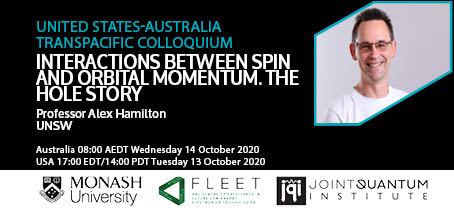-
14 Oct 2020
8:00 am - 9:00 am
Catch up: watch Alex’s presentation here.

FLEET Chief Investigator Professor Alex Hamilton (UNSW, Sydney)
Speaker: Alex Hamilton (University of New South Wales)
The electrical current in a semiconductor can be carried by negatively charged electrons or positively charged holes. Half of all the transistors in your iphone use holes, rather than electrons, to operate. In undergraduate physics, we are tell students that holes in the valence band are just an absence of an electron. But they aren’t. Valence band holes are spin-3/2 particles, and this gives them very different properties to spin-1/2 electrons. In recent years there has been growing interest in the possibility of using holes in semiconductor nanostructures for applications ranging from ultra-low energy electronics through to quantum information and communication.
The differences between electron and holes are most striking when they are quantum confined, due to the interaction between orbital and spin angular momentum. Understanding and controlling this spin-orbit interaction is key to proposals for creating artificial topological insulators, and spin-quantum bits. Here I present new results for detecting spin-orbit interactions of holes in gallium arsenide quantum confined systems, and discuss their implications for other materials systems:
(i) A new method for detecting spin accumulation: The ability to generate and detect spin accumulation via spin-orbit interaction in non-magnetic devices is an important asset in semiconductor spintronics. We have developed a new method for detecting spin accumulation based on the concept of a spin filter, exploiting the non-linear interactions between spin accumulation and charge. Since our non-linear method does not need a magnetic field nor a long spin diffusion length, it promises new possibilities for fast detection of spin accumulation in strongly spin-orbit coupled materials with short spin diffusion lengths, such as TMDCs and topological materials [1].
(ii) A new signature of spin-gaps in 1D systems: One dimensional semiconductor systems with strong spin-orbit interaction are attracting great attention due to potential applications to topological quantum computing. Applying a magnetic field can open a spin gap, a pre-requisite for Majorana zero modes. The characteristic signature of this spin gap is dip in conductance when a magnetic field is applied. However, disorder and interaction effects make identifying spin gap signatures challenging. We demonstrate an alternative signature for probing spin gaps, which is insensitive to disorder, and extract a spin-orbit gap ~500 μeV for holes in gallium arsenide quantum point contacts. This approach could enable one-dimensional hole systems to be developed as a scalable and reproducible platform for topological quantum applications [2].
[1] A non-linear spin lter for non-magnetic materials at zero magnetic field, E. Marcellina, A. Srinivasan, F. Nichele, P. Stano, D.A. Ritchie, I. Farrer, D. Culcer, and A. R. Hamilton, PRB (in press), https://arxiv.org/abs/1907.01312[2] New signatures of the spin gap in quantum point contacts, K. L. Hudson, A. Srinivasan, O. Goulko, J. Adam, Q. Wang, L.A. Yeoh, O. Klochan, I. Farrer, D. A. Ritchie, A. Ludwig, A.D. Wieck, J. von Delft and A. R. Hamilton, Nature Comms (in press).

